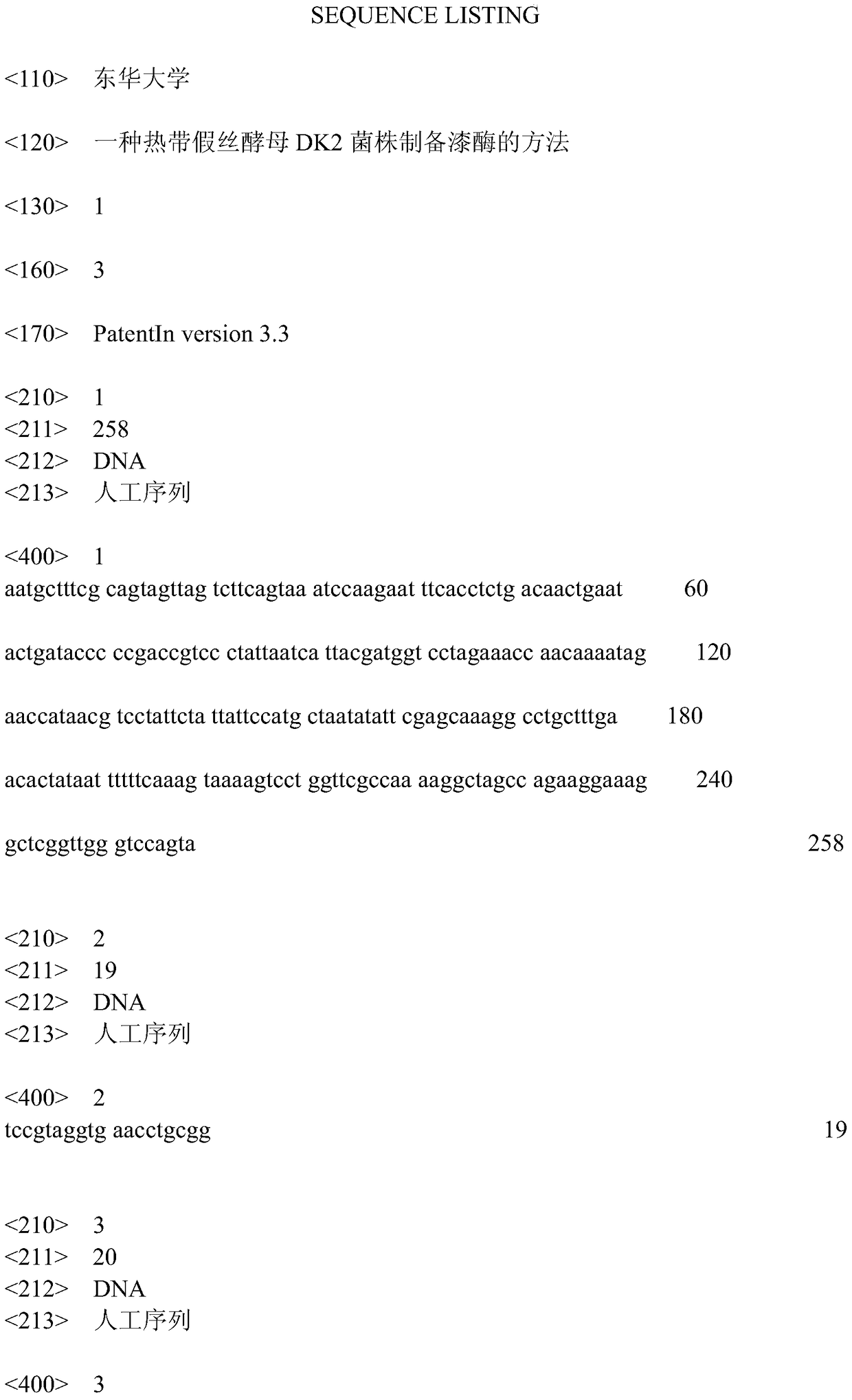A method for preparing laccase from Candida tropicalis dk2 strain
A technology of Candida tropicalis and strains, applied in the field of biological textiles, can solve the problems of high energy consumption of chemical degumming process, unrecyclable waste water, large equipment loss, etc., and achieves good application prospects, high degumming efficiency, and good quality effects.
- Summary
- Abstract
- Description
- Claims
- Application Information
AI Technical Summary
Problems solved by technology
Method used
Image
Examples
Embodiment 1
[0026] The method for preparing laccase from Candida tropicalis DK2 strain:
[0027] (1) Mycelia suspension: Candida tropicalis DK2 strain was transferred from PDA slant medium into a 300mL Erlenmeyer flask containing 50mL of basal liquid medium, and cultured in a shaker at 180rpm at a constant temperature of 30°C for 3 days, then fermented The liquid was filtered through sterile gauze, the mycelium was washed with sterile water and dispersed in a Waring high-speed crushing cup for 15 seconds, collected in sterile water (equal to the volume of the fermentation broth) to make a suspension of mycelia, and collected at 40 Store at ℃ for later use.
[0028] Basic liquid medium: 200g potato, 20g glucose, 1000mL distilled water, natural pH.
[0029] (2) Enzyme production in shake flasks: add 1% (w / v) natural substrate) and different concentrations of CuSO in the base liquid medium 4 ·5H 2 O (0-4mM) is the enzyme production medium. Put 80mL of enzyme-producing medium into a 300mL...
Embodiment 2
[0033] The process of degumming flax, jute, kenaf or bamboo fiber by preparing laccase crude enzyme solution from Candida tropicalis DK2 is as follows:
[0034] Put 5g of flax, jute, kenaf or bamboo fiber raw stems in a 250ml conical flask, and use flax, jute, kenaf or bamboo fiber raw stems and laccase crude enzyme solution in a mass ratio of 1:20 to pack in conical flasks 100ml liquid, degumming at 40°C, 200rpm shaker for 1 day, 2 days and 4 days respectively; when the degumming time is up, remove the degumming solution, boil in a boiling water bath for 5min, rinse with tap water several times, and Remove bacteria from linen and stop degumming.
[0035] Through the observation of flax, jute, kenaf or bamboo fiber degumming, it was found that after 1 day, the degumming of flax, jute, kenaf or bamboo fiber was obviously dispersed, and the color of the fermentation liquid became dark and turbid; , kenaf or bamboo fibers are dispersed into fibers, and the fermented liquid is ob...
Embodiment 3
[0037] The process of preparing laccase enzyme solution for degumming in flax, jute or kenaf yarn by Candida tropicalis DK2 is as follows:
[0038]Put 5g of flax, jute or kenaf yarn into a 250ml conical flask, and divide flax, jute or kenaf yarn and laccase enzyme solution into the conical flask according to the mass ratio of 1:20, and the liquid volume is 100ml , degumming at 40°C, 200rpm shaker for 1 day, 2 days and 4 days respectively; when the degumming time is up, remove the degumming solution, boil in a boiling water bath for 5min, and rinse with tap water several times to remove flax, jute or kenaf Bacteria on yarn, stop degumming.
[0039] Through the observation of flax, jute or kenaf yarn degumming, it was found that the flax fiber was obviously dispersed after 1 day, and the color of the fermentation liquid became turbid; Days later, the degumming rate of flax reached over 90%.
PUM
 Login to View More
Login to View More Abstract
Description
Claims
Application Information
 Login to View More
Login to View More - R&D
- Intellectual Property
- Life Sciences
- Materials
- Tech Scout
- Unparalleled Data Quality
- Higher Quality Content
- 60% Fewer Hallucinations
Browse by: Latest US Patents, China's latest patents, Technical Efficacy Thesaurus, Application Domain, Technology Topic, Popular Technical Reports.
© 2025 PatSnap. All rights reserved.Legal|Privacy policy|Modern Slavery Act Transparency Statement|Sitemap|About US| Contact US: help@patsnap.com



